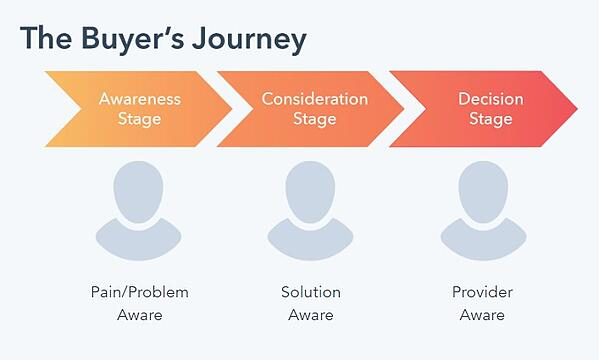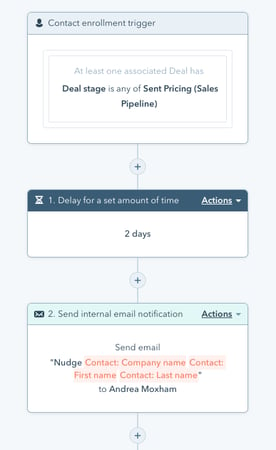Your business is growing. It’s harder to stay on top of what your sales, marketing, and operations teams are doing. And everyone you know is telling you that it’s time to implement a CRM like HubSpot, so you rush to sign a contract, spend thousands of dollars, and … nothing seems to get better. So what went wrong?
HubSpot implementations can fail for a lot of reasons, but one of the most common is that your business simply didn’t properly prepare to adopt a new CRM. And we don’t mean that it’s too expensive, or even that your business is too small. It’s that you didn’t do enough of the groundwork necessary to successfully set up HubSpot and use it in a way that makes sense for YOUR business.
So how do you know if you’re ready to implement HubSpot? Let’s dive in.
#1: You fully understand your customers
Before implementing HubSpot or any other CRM, you need to have a thorough understanding of your target audience. This can be broken into two sections: buyer personas and the buyers’ journey.
Buyer personas
A buyer persona is a fictional representation of your customers. Each persona goes into great depth about the individual, such as their demographics, their role in the company, what they’re hoping to accomplish, and their buying behavior. Most companies create 2-3 buyer personas and use them to make marketing and sales decisions, as they truly put you in the customer’s shoes.
New to buyer personas? Download our free worksheet!
Establishing buyer personas before implementing HubSpot is crucial for a couple of reasons. First, it allows you to customize the CRM to meet each persona’s unique needs with tools like custom properties and custom objects. It will also help you make decisions about content, your sales process, and more.
The buyers’ journey
The buyers’ journey is every step that a potential prospect or lead goes through before becoming a paying customer. It incorporates:
- How they originally discovered your brand (e.g. through a Google search)
- How they learned more about you (e.g. reading blogs on your website)
- How they decided to convert (e.g. talking to a sales rep and signing on)
The buyers’ journey will be unique to your business, and you may discover that your customers take multiple routes.

You cannot implement HubSpot without a clear, well-defined buyers’ journey as this is what informs the structure of your CRM. It enables your processes, defines when a lead will be passed between teams, and helps you make excellent content that meets your customers wherever they are.
#2: You have defined processes
HubSpot is a powerhouse of efficiency and automation. Yet when companies try to slap a new CRM system on top of broken, outdated, or redundant processes, the result can actually be more harm than good.
Before implementing any new system, you must document all of your business processes, including marketing, sales, and operations. Look for areas where things could be simplified or revamped entirely to make your employees’ jobs easier.
This way, when you take the leap into HubSpot, you’ll know exactly what you need to set up and how. You can use tools like sequences and workflows to overcome any gaps you identified and work towards continuous business improvement.

#3: You have objective goals
Too many companies make the critical mistake of implementing HubSpot without having any concrete goals. Ask yourself: are you actually trying to solve a specific problem with the system, or are you just hoping that a new piece of software will fix everything in your business?
You need to understand what you’re trying to accomplish, what metrics you need to measure, and what success looks like before you even start using the system. This will make it easier to set up the system for success and give everyone on your team solid expectations of ROI.
Any HubSpot goal should be a SMART goal: it must be specific, measurable, attainable, relevant, and time-bound.
#4: You’ve audited your tech stack
HubSpot is one of the most powerful platforms out there… but it can’t do everything for your business. Before implementing HubSpot, take a moment to audit your tech stack and consider the tools you’re currently using. Will some of them be replaced by HubSpot, or will you need new ones? Can you properly integrate the ones that you need to keep separate? Will they be able to scale with you as you grow?

If you neglect a thorough audit of your technology before switching to HubSpot, there are two likely outcomes: you’ll either continue to pay for tools that you don’t need, or you’ll miss out on key functionality that your business could be taking advantage of.
#5: Your teams are aligned
In traditional organizations, departments were distinct and only responsible for and concerned with their own area of the business. While factors like remote work and the increasing popularity of RevOps strategies are changing this model, some employees and teams are still reluctant or uncertain about sharing work.
This can be especially true for sales and marketing departments. But if you can’t achieve sales and marketing alignment, your HubSpot implementation is unlikely to succeed! The most powerful HubSpot strategies are those that empower every employee and team to do as much as possible to enhance the customer experience.
#6: You have a HubSpot champion
Implementing any new software or process can be a painful process. Aside from all the technology and logistic aspects, you also have to carefully navigate the human side of things. Employees may be uncertain, reluctant, or straight-up unwilling to use a new system or process, especially if “they’ve always done things this way”.
This is why it’s so crucial to select a HubSpot Champion (or team, depending on the size of your organization). This can be any employee who is excited and passionate about the system and will do their part to gently encourage others to get on board. The HubSpot Champion may be responsible for training on technology, providing support, or just general influence and enthusiasm.
#7: You’ve chosen a HubSpot partner
HubSpot has an incredible amount of help available to its users: a full knowledge base, a support community, and even HubSpot Academy courses. Yet even with these available, the platform can be complex and overwhelming, especially if you’ve never used it before.
With so much to know and master within HubSpot, we believe that every organization should work with a HubSpot partner, even if they have an assigned HubSpot champion. Even HubSpot partners hire other partners to grow their expertise!
A strategic HubSpot partner will help you truly hit the ground running and maximize HubSpot’s impact on your business from Day One. You need a partner who can advise you on strategy as well as the nitty-gritty technical details. Someone that can use their expertise to set up the system perfectly and then train you how to use it.
You need Horseshoe & Co.! Get a headstart on your setup by developing and executing an onboarding strategy tailored to your unique business needs. With expert instruction and future-proof implementation, onboarding is a breeze.
Is your business ready for HubSpot?
HubSpot can be a game-changing technology for organizations, but that doesn’t mean it’s right for you. Before implementing it or any other piece of software, you should always review your goals, streamline your internal processes, and put the right people in place to guarantee success.
Ready or not, Horseshoe can help! Whether you need help with some of the groundwork we outlined or can check every box and are ready to implement, our team of experts will take the headache out of HubSpot so you can focus your attention where it really matters: continuing to grow your business.



